David Dye's Blog, page 17
August 23, 2024
Uncovering Bias: How to Identify and Mitigate Systemic Issues
Episode 268: In this episode of the Leadership Without Losing Your Soul Podcast, David Dye sits down with Binna Kandola to explore the impact of bias on our thinking and decision-making. Bias can lead to snap judgments and stereotypes. Unconscious bias is even trickier because it’s the bias you’re not even aware of. In the workplace, this can show up in all sorts of ways—like favoritism, self-serving decisions, or even age bias.
So, what can you do about it? Recognizing and addressing unconscious bias is key to building a more inclusive, human-centered workplace. Start by pausing and reflecting before you make judgments. Make it a habit to seek out diverse perspectives and be open to feedback from others. While it’s tough to completely eliminate bias, raising your awareness and actively working to minimize its effects can lead to more inclusive and effective leadership.
Uncovering Bias: The Journey Begins00:00 – The Cognitive Tendency of Bias
You know, bias is a cognitive tendency, a way of thinking that can lead you to snap judgments. Ever meet someone and immediately think, “I’d never give this person a job,” before they’ve even said a word? The first step to uncovering bias is to pause and give people a chance, moving beyond those initial, often unfair, impressions.
00:18 – Welcome to Leadership Without Losing Your Soul
David Dye introduces the podcast, emphasizing its mission: to provide practical leadership tools that help you achieve transformational results without sacrificing your humanity.
01:06 – Meet Our Guest, Binna Kandola
David welcomes Binna Kandola, a business psychologist and expert in uncovering bias in the workplace. Binna’s impressive background includes co-founding a global consultancy, writing bestselling books, and receiving an OBE for services to diversity.
04:20 – Early Leadership Lessons
Binna shares a personal story about his first experience as a leader. It was a tough lesson in leadership and bias, as he had to drop a close friend from the cricket team because they weren’t good enough. This early experience highlighted the importance of making fair, unbiased decisions.
07:24 – What Is Unconscious Bias?
Binna explains unconscious bias as a misleading cognitive tendency that affects everyone. He describes it as a “bug in the system” that can lead you to make decisions that feel right but are actually biased.
10:20 – Self-Serving Bias
One of the most common biases is self-serving or egocentric bias, where you tend to see yourself as better than others. For instance, when 200 leaders at a global bank were asked to rate themselves on inclusive leadership, 100% rated themselves above average. Uncovering this bias is crucial for honest self-assessment.
14:49 – Age Bias
Binna highlights that age bias is widespread, with both younger and older people favoring youth. Interestingly, even as people age, they often internalize negative stereotypes about older adults, which can influence their behavior and decisions.
17:53 – Strategies to Mitigate Bias
To effectively lead, you need to start by uncovering bias in your own thinking. Binna suggests raising your awareness and taking simple actions, like pausing to reflect before making judgments. Moving from a snap decision to a more thoughtful one can help you make fairer, more inclusive choices.
21:06 – Becoming Conscious of Unconscious Bias
Binna emphasizes the importance of awareness in uncovering bias. He recommends being open to learning about different groups and listening to feedback, which can help you become more conscious of biases you didn’t even know you had.
24:34 – The Cost of Bias and the Benefits of Inclusion
The conversation shifts to the tangible impacts of bias in the workplace. Binna explains that bias, especially exclusion, can cause real emotional pain and undermine team performance. On the flip side, diversity combined with inclusion leads to higher innovation and productivity, making it a win-win for everyone.
41:12 – Is Bias-Free Leadership Possible?
David asks Binna if it’s possible to achieve bias-free leadership. Binna acknowledges that while you can work to reduce specific biases, there will always be new ones to uncover. The key is to stay open to feedback and keep learning.
42:46 – Getting Comfortable with Discomfort
Binna advises that becoming comfortable with the discomfort of uncovering bias is essential. Reflect on feedback and use it as an opportunity to grow. Over time, the gap between receiving critical feedback and responding with humility can shorten, leading to better leadership.
The post Uncovering Bias: How to Identify and Mitigate Systemic Issues appeared first on Let's Grow Leaders.
August 19, 2024
Managing Up: Turning Information into Influence with Your Boss
When your manager asks you for information, don’t just answer their question. Have a perspective. To get better at managing up, ask yourself three questions that will turn information into influence.
The Problem: Why Your Boss Is FrustratedEvery day we hear from frustrated executives buried in data. Their team sends them reams of information without context, PowerPoint decks that don’t answer the “obvious” question, or vague answers that lead to more questions.
And it’s all unnecessary. If your manager asks you for information and your answers don’t build your influence, or worse, cause frustration, you probably made one of a few mistakes.
Presenting Information: Common Managing Up MistakesAvoid these common mistakes when answering questions and presenting information.
Mistake #1: You Misinterpret or Underestimate the AskYou’re swamped and moving fast. There’s so much to do and then your boss asks for an update. And you want to be responsive, so you quickly throw together a chart that shows the last twelve months. But you don’t explain why February’s numbers were so different. Now your manager wonders why you don’t care about the obvious issue.
You’re so close to the project that your focus is on twigs and leaves, not the tree…and much less the forest. Your manager asks you for information. So you bury them in minutia that’s meaningful to you – but they wanted your perspective on the project’s success. And now they have to ask again.
Your manager asks for your analysis. So you put together a tight description of what’s happening and why. But you don’t make any recommendations. And your frustrated manager wonders, “What am I supposed to do with this? Shouldn’t you be able to solve these problems?”
Mistake #2: You Think Your Boss Thinks Like YouEveryone has a natural style of how they get information and make decisions. But these styles differ from one person to the next.
Maybe you prefer to read. So you prepare excellent written emails and reports – that your manager ignores. Because she prefers to listen and talk through the information. Or, you like to see all the data when deciding, so you give them everything. But they just want a summary, or your suggestion.
Mistake #3: You Try to Stay Out of TroubleYour manager asks for an update and you bury the bad news in a spreadsheet or a hundred-slide presentation. Rather than interpret the data and risk a negative reaction from your manager, you dump it all on them and leave them to figure it out.
Or you don’t offer a point of view or recommendation because you worry about how your manager will react.
After all, they can’t get mad at you if you said nothing wrong, right?
Well, wrong…of course they can still get upset. And now, to make it worse, you didn’t actually do your job because you didn’t lead.
Mistake #4: You Try to Look Too GoodThere’s a time to show your work. But going overboard makes you look insecure, not competent.
When you showboat and point out how outstanding you are, you cast doubt as to your true capabilities. Worse, in the effort to show off, you miss the chance to genuinely help and build the influence you want. You’ll have much more influence managing up when you add true value.
Three Managing Up Questions to Turn Information into InfluenceAvoid these four mistakes and add value by asking yourself three key questions. If you aren’t confident in your answers to any of the questions, use these communication tools and Powerful Phrases to maximize your influence.
1. What does your manager need?This is the most important question to make sure that you add value. What does your manager actually need?
Ask yourself this question a couple times, from different angles.
Because your manager might not ask for what they need.
They’ll ask for what they think they need. Or they ask for the first part, but not the second and third pieces. Maybe they don’t understand the issue as well as you do, so they ask the totally wrong question. Or they don’t specifically ask for your recommendation, but they expect you to have one.
Here are ways to think about what your manager needs:
How will they use the information? Will they make a decision? Pass it to someone else? Implement your suggestion?Quick or detailed? What level of confidence do they need? Do they need a precise, accurate answer, or is a quick range enough for now?Do they need nicely formatted to share with others or just an email with a simple answer?What are the next three questions your manager would naturally ask? Answer these.Always have a perspective. Whether your manager asked for it, you need to be read to offer a point of view. You are closer to the work. What would you recommend?
If you’re not sure what your manager needs, there are a couple of questions you can ask to help clarify:
Check for Understanding by saying, “Here’s what I’m hearing you need and how you will use the answers I give you: ________. Do I have that right?”When you don’t have enough information to check for understanding, you can draw out more information by asking: “I want to make sure I get you what you need. What will a successful update do for you?”

When you work with a manager frequently, you can ask this question early in your relationship. If you don’t know the person making the request, include this question in your first conversation:
“How do you like to receive information?”
Some possibilities to explore include:
Written, diagramed, or spokenBullet point summaries or analysisNumbers, narrative, or bothWhen you can’t know how they need it, try this: start with a one-page brief, bulleted summary of key information and your recommendations. In the following pages, give them the data and analysis. Then make yourself available to discuss the report.

You don’t want to waste time if they need it quickly. Nor do you want to drop everything and abandon your work to provide a report that could wait until next week.
The tool to help you manage these priorities is Scheduling the Finish.
You never want to leave a conversation that requires action without scheduling the finish by addressing three factors:
Ideally, when will the task be complete?Is this workable, or do you need to resolve competing priorities?Is the scheduled finish on your calendar (and the calendar of anyone else involved)?For example, your manager asks for an update on the sales figures for your newest product. You know she prefers written bullet points and the ability to ask clarifying questions.
First, you ask how she’ll use the data and whether she wants the actual data or a trend analysis. Then you schedule the finish by asking, “Ideally, when do you need this?”
She asks for the information by tomorrow afternoon.
You have time at 4:00 pm available to meet. But you also have to attend a marketing update in the morning that won’t leave you time for her update.
So, you tell her, “If I can skip that marketing meeting, I can send you the information at 3:00 and then we can do a quick video call at 4:00 so I can answer your questions? How does that sound?”
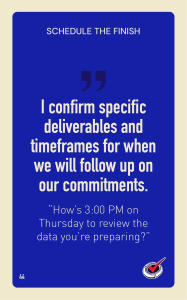
You can master the art of managing up, increase your influence, and get your manager the right information at the right time by answering three critical questions: What do they need? How do they need it? When do they need it?
We’d love to hear from you: what’s one of your best ways to get your manager the information they need to lead well and make good decisions?
You Might Also Like:Help Your Boss Stop Wasting Time with Bad DelegationPowerful Phrases to Win With a Moody Boss, Even a Dropper of F-BombsManaging Up With Grace (How to Give Your Boss Better Feedback With Video)The post Managing Up: Turning Information into Influence with Your Boss appeared first on Let's Grow Leaders.
August 16, 2024
Storytelling Mistakes: Do This, Not That for a More Memorable Story
Done well, strategic storytelling will make you If you want to be a better storyteller, avoid these storytelling mistakes.
Avoid These Strategic Storytelling Mistakes

You want to be a better strategic storyteller, so how do you up your game? How do you tell a memorable story that has the impact you desire?
Today, I talked with Carrie Beckstrom about the most common mistakes people make when telling stories and what to do instead.
Use a storytelling framework to keep your story tight and on message. Distinguish the nice-to-have details from the must-haves.
2. They lack purpose.Think about your audience and what you want to achieve.
(I like to say what do you want your listeners to “think, do, and feel” as a result of hearing your story.)
Use emotive language and sensory detail to keep it interesting.
More Ways to Craft a Better Story (Do THIS, Not THAT)Do: Be clear about your messageThe difference between business storytelling and telling a great story around the campfire or in your favorite bar comes down to one thing– the point.
Whether your audience is an employee in the passenger’s seat of your car on the way to an event, a small group of direct reports in a team meeting, or a thousand people at a town hall meeting, ask yourself this: “What do I want my audience to think, do or feel as a result of this story?” Be as specific as possible.
Think beyond the obvious feelings of “encouraged” or “motivated.” And consider specific behaviors or key actions you want them to take next.
Do: Pick a Relatable SceneI can’t tell you how many corporate events we go to where the CEO starts with a story from an unrelatable setting. “When my family of five and I were on a cruise last week, the funniest thing happened…” And all the frontline workers who are struggling to make it through the month, tune out. They lost that story at hello.
Do: Keep it TightAs Carrie recommends in the video, don’t let your story ramble. It’s tempting to offer every chronological detail and play-by-play. Don’t. Great stories focus on the emotional truth. Don’t make stuff up, but it’s perfectly okay to condense the details and the characters to build suspense, intrigue, and most importantly reinforce the point.
Do: Give Your Characters CharacterPaint a picture of your characters. What did they look like? What did they wear? Why? Give us a glimpse into their fears and motivations. If you’re the main character in your story, give us a look behind the curtain. What were you feeling? Why?
D0: Check for UnderstandingIf you’ve been in any of our leadership programs, you know how committed we are to a solid check for understanding in every communication. After your story, instead of saying, “The reason I told you that story is…” Try, “Why do you think I share that story?” If they don’t get it, refine your story to ensure it conveys your most important message.
Don’t: Be the Hero of Your Own StoryEven if you are the hero, who else was involved? How can you emphasize their impact? And then I met __________ who had the best idea I’ve heard in a long time…
Don’t: Tell Stories Within the StoryLife is messy. No story happens in a vacuum. But, the most impactful business storytelling happens one story at a time. Do what you can to avoid the detours.
Don’t: Wing itGreat storytellers make it look easy. Like the story just came to them and off they go. The very best storytellers know there is nothing further from the truth. Becoming a great storyteller takes practice. Try out your stories in low-risk contexts, ask for feedback and keep refining.
Your turn. What are storytelling mistakes do you recommend business storytellers avoid for a better story?
The post Storytelling Mistakes: Do This, Not That for a More Memorable Story appeared first on Let's Grow Leaders.
Genius Leadership: Strategies for Success and Sustainability
Episode 267: In this episode of the Leadership without Losing Your Soul podcast, you’ll dive into an engaging conversation about genius leadership with your host, David Dye, and special guest Melanie van de Velde, author of Lead Like a Genius. You’ll explore how justice should play a role in how rewards are distributed in business—whether based on talent, effort, or risk. Melanie shares her insights on the power of staying true to your purpose, even drawing from childhood memories that shape who you are as a leader.
As you listen, you’ll learn about the natural human instinct to care for one another and why businesses should never lose sight of this. Melanie also introduces the concept of “just payments” and emphasizes the significance of fair compensation in the workplace.
You’ll discover the “impact wheel,” a tool Melanie uses to break down the United Nations’ Sustainable Development Goals (SDGs) into four key focus areas that can help companies address root causes effectively: empowerment, just payments, health and wellbeing, and climate action. The episode wraps up with a thought-provoking discussion on the difference between good and bad profit and how merging profit with impact can pave the way for a better future.
Unlocking Genius Leadership(00:00-02:14) Dive into the essence of genius leadership with a thought-provoking discussion on justice and fairness in business. You’ll hear how the principle of justice, rooted in ancient Roman law, should influence how we distribute rewards in business based on talent, effort, and risk. This sets the stage for a conversation that challenges conventional thinking about leadership and justice.
(02:15-05:19) David introduces the guest, Melanie van de Velde, and her inspiring journey from senior management in a multi-billion-dollar tech company to becoming a champion of social justice in business. Melanie’s story is a testament to the power of staying true to your purpose and using your experiences to shape your leadership journey.
Genius Leadership: Embracing Humanity(05:20-09:19) Melanie discusses how her childhood experiences, particularly witnessing the Ethiopian famine, sparked her desire to make a meaningful impact. You’ll learn how those early memories shaped her leadership philosophy, emphasizing the importance of aligning your work with your deeper values.
(09:20-13:33) Next, explore the concept of “just payments” as Melanie explains the importance of fair compensation in business. This is a key element of genius leadership—ensuring that everyone involved is fairly rewarded for their contributions. You’ll gain insights into how this approach creates a more just workplace and drives better business outcomes.
The Impact Wheel: A Genius Leadership Tool(13:34-21:17) Melanie introduces the “impact wheel,” a tool designed to help companies align with the United Nations’ Sustainable Development Goals (SDGs). She breaks down how businesses can focus on four key areas—empowerment, just payments, health and wellbeing, and climate action. Effectively tackle root causes and create lasting impact. This is a must-listen segment for anyone looking to integrate genius leadership into their business strategy.
(21:18-29:42) Discover practical examples of how businesses can implement the principles of the impact wheel. Melanie shares stories of companies that have successfully balanced profit and purpose, illustrating how genius leadership can lead to financial success and positive social impact.
Balancing Profit with Impact(29:43-37:27) Learn about the difference between good and bad profit. Understand why you should pursue profits that create value for society. Melanie’s insights on this topic are eye-opening. Learn how genius leadership is about more than just the bottom line—it’s about making a positive difference in the world.
(37:28-45:48) Dive into the practicalities of implementing genius leadership in various business contexts. Whether you run a small business or are part of a larger organization, Melanie advises making changes that align with the principles of justice and empowerment.
Leading Like a Genius in Action(45:49-53:40) Melanie shares inspiring examples of businesses that successfully implement genius leadership principles, from paying workers fairly to creating opportunities for disadvantaged groups. These stories illustrate how leaders can drive positive change in their organizations and beyond.
(53:41-57:23) The conversation concludes with a powerful message for all leaders. You can make a difference, no matter your position. Melanie encourages you to take practical steps toward integrating profit and impact in your work, embodying the essence of genius leadership.
The post Genius Leadership: Strategies for Success and Sustainability appeared first on Let's Grow Leaders.
August 12, 2024
My Boss Thinks I Need to Be a Better Team Player, Now What?
Your boss tells you you need to be a better team player. And you think, “Wait, what? Me? Where is this coming from? I AM a team player. Do you know how much I care about this team and the work we do? Do you SEE how hard I work?”
But that’s your inside voice.
You don’t say THAT because you also care about your career and want your boss to respect you.
So what do you do next? How do you get underneath this vague (and frustrating feedback) and decide what to do next?

“You are not a team player” is fuzzy feedback. It’s right up there with “you need to be a better critical thinker,” or, “be more strategic.” It’s hard to know exactly what that feedback means. Your best bet is to get curious and specific.
1. Ask for the CLARITY you needThe key here is to show up genuinely curious (and not defensive). If your words, tone of voice, or facial expression scream “I’m not interested in your F$*@#&% fuzzy feedback, you’re not helping your “I’m a team player” case.
Try this instead:
2. Look for PATTERNS“Hey, thank you so much for caring about me and my career and wanting me to be successful. I want to be a team player. What do you think I could do so people see me as collaborative?
Have you received this kind of feedback before? Because if there is a pattern, you want to pay attention to it.
Consider the unintended consequences of your well-meaning actions. Is your passionate nature being interpreted as aggression? Is your concern about getting it right, or avoiding problems, coming across as negative?
NOTE: If you think this is an issue, check out David’s Leadership Without Losing Your Soul Podcast episode: How to Be a Less Negative Leader.
3. Identify the HABITS that will enhance collaboration and change perceptions.
Based on your feedback and self-reflection, identify one or two specific habits that will help you to be a better team player.
For example, suppose you learn you need to slow down and build relationships. In that case, you might choose a connection habit like reflecting the emotion you’re hearing, or taking time to learn about your coworkers’ people, pets, and projects.
Or, if you get feedback that you don’t appear receptive to new ideas or alternative ways of doing things, here’s a list of curiosity habits you might choose to work on.
One way we do this with our clients is to use our SynergyStack™ Team Development system, based on four dimensions of collaboration: connection, clarity, curiosity, and commitment.
4. Create a Mini-Personal ExperimentOf course, identifying the habits is the “easy” part. Now it’s time to translate that habit into tangible action. One way to do this is to choose a mini-personal experiment to engrain the habit. A mini-personal experiment is a new behavior or action that you will try for two weeks.
A mini-personal experiment should meet the following criteria:
It’s easy to do every dayIt will help engrain a habit you desireAnd, it’s slightly uncomfortable– encouraging you to try something new.5. Invite Ongoing FeedbackIn our recent interview with world-renowned coach, Marshall Goldsmith he said, “Changing behavior is easy, changing perceptions of others is hard.” One of the best ways to do that is to let people know what you are working on. That way, when they see a change in behavior or a new habit, they are more likely to notice it.
The key is to get underneath the fuzzy feedback, so you can decide what you want to do next by focusing on tangible habits.
See Also:Expert Strategies for Handling Vague Feedback From Your Boss (Podcast)
Why Your Great Boss Might Be Hurting Your Career
The post My Boss Thinks I Need to Be a Better Team Player, Now What? appeared first on Let's Grow Leaders.
August 9, 2024
Leading with Purpose: How to Cultivate an Aliveness Mindset
Episode 266: In this episode of “Leadership Without Losing Your Soul,” David talks with Jack Craven, a trial lawyer turned CEO, aliveness mindset author, and executive coach. Jack shares his journey of leading business leaders toward more fulfilling lives, emphasizing the importance of feeling alive professionally and personally. They delve into the “aliveness mindset,” which focuses on bringing passion, purpose, and joy into everyday experiences. Jack introduces the idea of anchoring mindsets and the significance of practices like self-awareness, authenticity, and courage. They discuss the role of tenacity in achieving goals and the importance of love and connection in leadership. This episode encourages leaders to reflect on moments when they felt most alive and to integrate practices that foster continuous personal and professional growth.
Discovering the Aliveness MindsetTransform your leadership approach with passion, purpose, and joy.00:00 – The Power of Small Steps
If you ever feel stuck, remember that the goal isn’t always to get out of the hole immediately. Sometimes, just taking a step toward the ladder is enough. Give yourself grace on tough days.
00:15 – Welcome to Leadership Without Losing Your Soul
Host David Dye introduces the episode, sharing insights from a Pew Research study about the importance of job satisfaction and the surprising statistic that many leaders feel dissatisfied with their work environment.
01:47 – Introducing Jack Craven
Meet Jack Craven, a diverse leader with experience as a trial lawyer, CEO mindset author, and executive coach. Jack helps business leaders achieve more fulfilling, authentic lives.
03:02 – Jack’s Early Leadership Experience
Jack reflects on his early leadership role as a Rush chairman in college, highlighting how his leadership journey began and the long-lasting friendships he formed.
04:29 – Critical Questions for Aliveness
Jack asks two foundational questions from his book, “Aliveness Mindset“: “When did you last feel alive?” and “What if you could feel like that every day?” Reflect on your answers to these powerful questions.
Anchoring and Embracing Aliveness05:48 – Defining Aliveness
Aliveness isn’t just a fleeting moment of excitement; it’s about feeling alive in mind and body, bringing the best version of yourself into your daily experiences.
07:02 – The Role of Anchoring Mindsets
Learn about anchoring mindsets like play, connect, learn, grow, and have an impact. These mindsets help you stay grounded and navigate challenges with an aliveness mindset.
09:42 – Facing Challenges with Aliveness
Jack discusses handling significant life challenges by asking yourself, “What’s one thing I could do to feel alive today?” Sometimes, small steps, like planning a date night, can make a big difference.
13:22 – Authenticity in Leadership
Authenticity is about bringing your true self to your leadership role. It’s essential for creating a genuine connection with your team and fostering an environment of trust.
17:40 – Tenacity and the Long Game
Embrace tenacity to achieve your goals. Whether you’re running a marathon or writing a book, tenacity keeps you moving forward, even when facing setbacks.
The post Leading with Purpose: How to Cultivate an Aliveness Mindset appeared first on Let's Grow Leaders.
August 5, 2024
Beyond Magical Thinking: How to Ensure Your Team “Gets It”
Magical thinking means you assume your team knows what you know. For example, you might think that explaining a task once is enough and everyone will understand and execute it perfectly. Of course, your team might not get it. It’s your job to ensure expectations are clear.
How Magical Thinking Leads to Workplace ConflictThink about any significant conflict you’ve been a part of. Chances are “magical thinking” crept in. “Magical thinking” happens when you take clarity for granted.
You assume they should know what’s expected because ________ fill in the blank here (they’ve been trained, you’ve covered this in the last five team huddles, it’s “common sense, or their mama should have taught them better.)
But sadly, somehow, they don’t.
Suppose you’ve implemented a new AI system for handling customer questions. In your mind, the transition should be smooth. After all, your team has been trained, and the system is user-friendly—shouldn’t they “know” how to handle any hiccups?
But here’s where the magical thinking kicks in. You expect them to troubleshoot minor issues and put in a ticket as they arise They wait for the IT guy to ask how it’s going.
You pop in for a skip-level meeting and get bombarded with complaints.
“Why didn’t you say something!” You say in exasperation.
“Well, no one asked.” They respond with a shrug.
No one’s meaning to cause conflict or stress. But there you are.
We all carry around expectations of one another. And sometimes, you don’t even know what you expect until someone doesn’t live up to it.
Some of the most significant examples of conflict in our World Workplace Conflict and Collaboration Survey stemmed from a lack of clarity—there was no shared understanding of success.
Techniques To Prevent Magical ThinkingThe antidote to magical thinking is clarity. Three foundational habits we teach in our leadership programs will help.
1. Technique #1: Communicate Consistently: Five By Five CommunicationIf you have a strategic message that you need people to remember, don’t communicate it once and wait for the magic. If something is important communicate it 5 times, 5 different ways.
More on 5×5 Communication here. Or hear more about it on David’s Leadership Without Losing Your Soul Podcast.
See Also: How to Choose the Right Communication Method for Your Message
2. Technique #2: Check for UnderstandingOf course, setting clear expectations about what matters most and communicating what’s important five times, in five different ways is not enough. You need to check to ensure your team gets it.
A check for understanding is a simple check to see if your team picks up what you’re putting down.
More details on this vital leadership communication technique here.

Life can get a bit crazy and your team has more to do than time to do it. Their interruptions will get interrupted. If you don’t have an intentional, focused way to finish what you start, it won’t happen.
Successful leaders don’t leave the finish to chance or a heroic act of willpower.
That’s where scheduling the finish comes in.
Scheduling the finish means you and your team don’t leave the completion of critical items to chance, good intentions, willpower, or magical thinking.
Rather, you schedule a mutual moment in time where you will follow up, follow through, and finish the task. This isn’t a vague intention—it’s an appointment on the calendars of everyone involved.
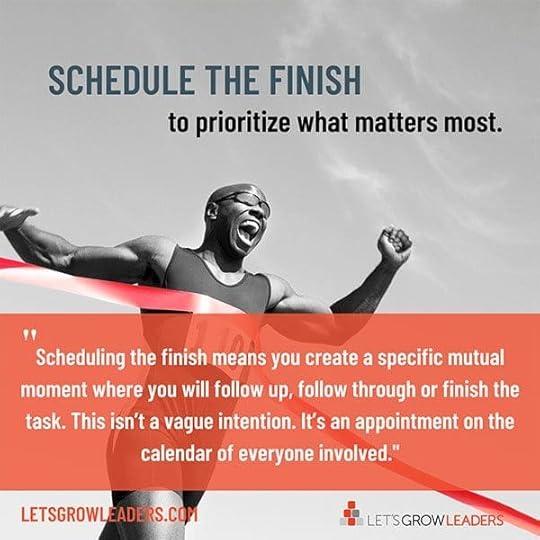
More on how to schedule the finish here,
Why This Matters to You
Clear communication cuts through the chaos, reducing misunderstandings and setting the stage for less stress, more calm, and better collaboration.
Your turn.
What is your favorite way to prevent magical thinking?
The post Beyond Magical Thinking: How to Ensure Your Team “Gets It” appeared first on Let's Grow Leaders.
August 2, 2024
What Are Some Fun Workplace Conflict Team Building Activities (Asking for a Friend)
to Help Your Team Reduce Stress, and Make Work, Work Better
The best time to talk about team conflict is before you’re in it. And, a good conflict teambuilding exercise makes talking about conflict easy. That’s why we’ve developed these FREE practical and fun workplace conflict team building activities to go with our new book, Powerful Phrases for Dealing with Workplace Conflict.
These easy-to-facilitate exercises make it easy for you and your team to read Powerful Phrases together. And, to discuss how you will handle conflict BEFORE it happens.
First watch this quick, Asking for a Friend video which gives examples of these workplace conflict team building activities in action.

Note: If you’re curious and want to watch the classic Asking for a Friend on uncovering simmering workplace conflict I call back to, you can do that here.
What You’ll Find in the Conflict and Collaboration Resource CenterBook Group Discussion QuestionsTraining & Teambuilding Activities (including crafting your conflict cocktails, reflective phrases mapping, and G.O.A.T. citings) Role Play Scenarios (Scenarios for How to Say No, Dealing with a Credit Stealer, and Feeling Overwhelmed)Book Group Planning Tips and TemplatesWe’d love to hear from you. Have you tried any of these workplace conflict teambuilders? Let us know how it went. Even better, send us some pics!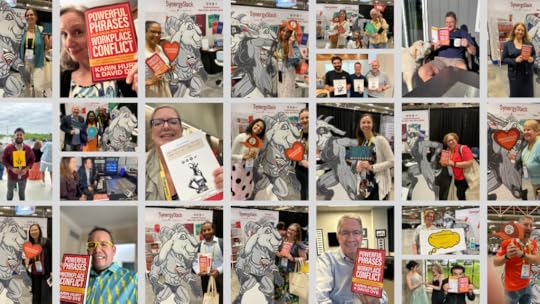
The post What Are Some Fun Workplace Conflict Team Building Activities (Asking for a Friend) appeared first on Let's Grow Leaders.
Going Beyond Leadership Skill Training to Unlock Potential
Episode 265: In this episode of the Leadership Without Losing Your Soul Podcast, David Dye and Lori Mazan invite you to rethink the way you approach leadership. Skill training is just the beginning; true leadership goes beyond that. They emphasize the importance of integrity, individuality, and personal development, encouraging you to break free from outdated beliefs that there’s only one right way to lead.
You’ll learn why relying on your internal compass and enhancing your thinking are crucial steps to elevate your leadership. David and Lori highlight the need for more personalized and contextual development, stressing the importance of aligning your thoughts and engaging in open, honest conversations.
By the end of the episode, you’ll discover the concept of finding the “third right answer” and how to break out of habitual thinking patterns, ultimately unlocking your full potential as a leader.
Leadership Fundamentals – Beyond Skill Training(00:00) Integrity and Internal Compass
Lori starts by highlighting that integrity and having an internal compass are crucial for exceptional leadership. It’s this inner guidance that helps leaders make the right decisions and distinguishes good leaders from great ones.
(00:17) Outdated Practices in Leadership
David introduces the episode by discussing how many leadership practices are outdated. He humorously points out that while the 1980s were great for music, they weren’t so great for leadership training. He sets the stage for discussing modern, effective leadership strategies.
(01:12) Early Leadership Experiences
Lori shares a charming story about her earliest leadership experience at nine years old, running a neighborhood school while wearing roller skates. This anecdote illustrates the importance of individuality in leadership.
(04:01) Learning from Past Leadership Models
Lori recalls her father’s role as a presidential appointee and her observations of leadership in the White House. These experiences shaped her early understanding of leadership and the importance of integrity.
(06:23) Adapting to Modern Leadership Needs
David and Lori discuss the need for a revolution in leadership approaches. They stress that training leaders as if it’s still the last century doesn’t work in today’s rapidly changing environment. Leaders need to develop personalized, contextual strategies.
Advanced Leadership Strategies(12:49) Beyond Skill Training
Lori argues that while skill training (e.g., conflict management, listening skills) is essential, it’s not sufficient. Modern leaders need to integrate these skills with their authentic approach to handle complex, unpredictable environments.
(19:22) Challenges of Performance Evaluations
Performance evaluations are criticized for their inefficacy. Lori suggests a mindset shift from authoritarian evaluations to alignment conversations, focusing on helping employees succeed through understanding and support.
(25:54) Personalized Coaching
Lori advocates for executive-style coaching for all leaders, not just top executives. She explains that coaching helps leaders make significant leaps in their development, adapting to the fast-paced changes in today’s work environment.
(38:11) Thinking Beyond the Binary
The concept of the “third right answer” is introduced. Lori emphasizes moving beyond binary thinking (A or B) to find innovative, effective solutions that better address modern leadership challenges.
(42:27) Self-Coaching and Development
David and Lori conclude by discussing practical steps for self-coaching. They highlight the importance of asking higher-level leaders about their thinking processes to gain new perspectives and develop as a leader.
 If you’d like specific, practical phrases and approaches for common sources of workplace conflict, check out our newest book: Powerful Phrases for Dealing with Workplace Conflict—What to say next to de-stress the workplace, build collaboration, and calm difficult customers.
If you’d like specific, practical phrases and approaches for common sources of workplace conflict, check out our newest book: Powerful Phrases for Dealing with Workplace Conflict—What to say next to de-stress the workplace, build collaboration, and calm difficult customers.
The post Going Beyond Leadership Skill Training to Unlock Potential appeared first on Let's Grow Leaders.
July 29, 2024
Managing Change: How to Cultivate Forward Thinking Leadership
Are you hanging on to a familiar way of doing your work or leading your team because it’s comfortable? If it’s been a year or more since you experienced a significant change for yourself or your team, you might be missing out on great opportunities to build morale, build your career, and enjoy your work. Managing change is critical for your success—too much change, too quickly creates instability. But resisting natural, healthy change will prevent growth and stagnate your team.
Resisting Natural ChangeOff the east coast of North Carolina and Virginia, a set of barrier islands known as the Outer Banks stretches over a couple hundred miles, guarding the inner sound from the worst of Atlantic storms. On a recent visit, our brother-in-law Steve, who’s visited these beaches and dunes for decades, took me on a driving tour and pointed out some changes he’s seen over the years.
He pointed across the road at a five-foot rise of sand you could walk across in a few steps. “To climb that dune, you used to have to work at it and scramble on all fours. It was huge.” We drove a little further and earth-moving equipment worked to keep blown sand from obliterating the narrow strip of asphalt road as the wind seemed to fight to reclaim and reshape the island.
Then he showed me the Oregon Inlet where private deep-sea fishing boats enter and leave the sound. “In the early 1800s the inlets all closed up and there weren’t’ any islands at all. It was a straight stretch of sand. Then, in 1846, a hurricane carved out the inlet. These days, sand keeps filling it in, and they have to dredge it out regularly so the fishing boats can get in and out.”
The Outer Banks are a land of change. And it takes an incredible amount of work to prevent that change. And some day, given a big enough storm, the change will probably happen anyway.

The visit reminded me of the mountain west where I grew up. In the mountains, lodgepole pine forests evolved to burn periodically. Quick burns opened the forest floor to new plants, refreshed the soil, helped cones to disperse seeds, and prevented disease or insect infestations. Decades of fire prevention along with climate change, created huge, intense burns and stands of diseased dead trees. Resisting that natural change came at an enormous cost.
Resisting Business ChangeYou’re certainly familiar with companies like Blockbuster and Kodak who resisted change and faced extinction. It’s easy to shake your head and wonder how those leaders could have let that happen.
But the CrowdStrike bug that crashed Windows PCs, snarled airlines, and interfered with hospitals’ ability to access patient records had a similar cause. Microsoft tried to shift its approach to security two decades ago, but regulators prevented them from doing so.
Why?
Because the software giant had always allowed open access to their computers’ kernel and some companies had built their entire business model on that access. (Access that Apple and Linux have never allowed.)
When Microsoft tried to do what Apple and Linux have done, the companies who relied on kernel access went to regulators who ruled in favor of the status quo, rather than allowing developing technology to address the situation. And that decision created the conditions that allowed the CrowdStrike crash to happen. (For a full analysis, check out Ben Thompson on Stratechery: Crashes and Competition.)
Again, it’s easy to point the finger at regulators who get stuck in time and cling to the way things are.
But intentional change isn’t easy.
Build Your Ability to Lead Change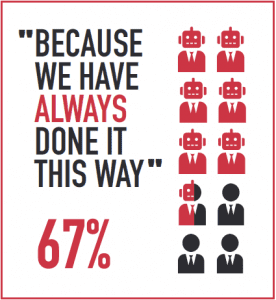
In our research for Courageous Cultures, 67% of respondents reported that their manager was stuck in “that’s the way we’ve always done it” thinking.
And you don’t have to look very hard to find places you might be stuck. I’ve been guilty of these at times:
Holding on to a team member that you should promote or give other opportunities outside your team—because you don’t know what you’d do without them.Hanging on to team member that you really should move off the team—because then you’d have to find someone new and train them.Continuing the stale team-building activity everyone loved five years ago—because it always worked before.Refusing to decide—because going one way or the other will take effort.Resisting new ideas from team members—because hearing them out might mean you don’t have the answers you thought you did or will require you to act.Hoping against all evidence that the recent changes you’ve experienced will “go back to normal” – because acknowledging the change will require energy and effort to explore a new path forward.But ignoring or resisting these moments of natural change won’t work forever.
The status quo’s comfort and ease are illusions. If you don’t invest in managing change, the changes will happen to you.
That team member will leave. Or they’ll stay and everyone else will leave.
Your credibility suffers. Your career lags. And you’re stuck frantically trying to do what used to work, working harder, with more stress, and missing out on what’s possible.
Two Questions to Find the Flow and Know What’s NextOne of the easiest ways to lean into natural change is to ask yourself this question:
What are you up to?As a team leader, manager, or executive—what are you getting up to?
Is there a problem you’re trying to solve?Are you helping your team to grow?An opportunity to explore?Some improvement or process you’re implementing?What are you learning?When you’re up to something, you’re managing change. You can’t help it. You’re moving, flowing, and growing. Once you’re up to something, you can start managing change:
Challenge yourself and your team to answer strategic or these UGLY questions to uncover possibilities:Ask your team for their I.D.E.A.s.Consider competing values and priorities.Make decisions about what matters most.When you get up to something, you collaborate with natural change and create the future, rather than have it happen to you.
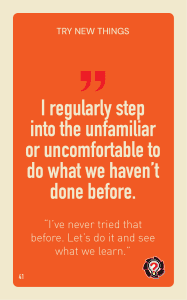
A second question you can ask yourself to find the flow of natural change is:
What’s happening in my industry?No matter what kind of work you do, there’s something new to learn. Technology changes. Trends shift. Someone somewhere is innovating. And it’s easier than ever to learn what’s happening.
You might not apply what you learn immediately. Changes in the business environment, shifting tastes, or new AI applications may not affect your work tomorrow (though they could).
But knowing what’s happening and being informed will give you the perspective to be better at your work and be a better leader for your team.
What if My Boss Isn’t Managing Change and Doesn’t Want To?If you want to get up to something or start learning more about what’s happening in your industry, but you worry that your boss just wants you to “focus on doing what needs to be done,” there are two possibilities:
You need better results.We’ve worked with many leaders who were eager to get up to something new, but weren’t succeeding at their current work. You’ll be much more influential in selling a new idea or approach if your current work is solid. Master that, then build on your success.
You’re doing well and your manager fears change.If you can objectively show your success, but your manager still wants you to limit your focus to doing what you’re asked, they might be the one hanging on to what they know.
In this case, keep doing your work well—and get up to something anyhow. You’ll have opportunities—the world needs more thoughtful, innovative problem solvers than ever. “Just shut up and do your work” isn’t a path to the future. What you learn will serve you and your team.
And you don’t need permission to learn.
Your TurnManaging change is a critical leadership skill. Sticking with what’s familiar feels safe and comfortable, but change is inevitable. You can lean into change and become a more innovative, creative, and adaptable leader by taking initiative to move and actively learning.
How about you? We’d love to know one of your favorite ways for managing change and leaning into the future.
And if you want to help your team or organization drive innovation and improve results:
The post Managing Change: How to Cultivate Forward Thinking Leadership appeared first on Let's Grow Leaders.









